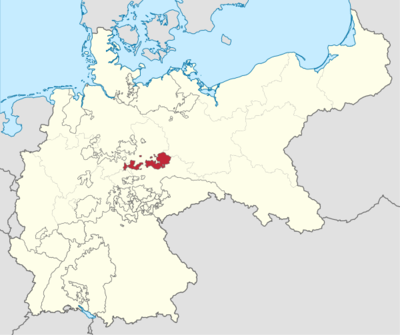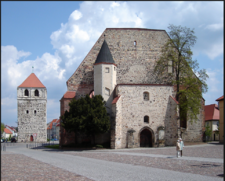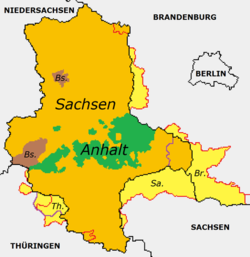Anhalt, German Empire Genealogy
Guide to Anhalt, German Empire ancestry, family history, and genealogy before 1945: birth records, marriage records, death records, both church and civil registration, compiled family history, and finding aids.
Historical Background[edit | edit source]
- The Duchy of Anhalt was a historical German duchy. The territory is now part of the federal state of Saxony-Anhaly (Sachsen-Anhalt).
- Anhalt’s origins lie in the Principality of Anhalt, a state of the Holy Roman Empire.
- In 1806, Napoleon elevated the states of Anhalt-Bernburg, Anhalt-Dessau and Anhalt-Köthen to duchies. These duchies were united in 1863 to form a united Anhalt.
- The new duchy consisted of two large portions – Eastern and Western Anhalt (separated by part of Sachsen), and of five small enclaves, each surrounded by Prussian territory:
- Alsleben
- Muhlingen,
- Dornburg,
- Gödnitz, and
- Tilkerode-Abberode.
- In 1918, Anhalt became a state within the Weimar Republic. After World War II. It was united with the Prussian parts of Saxony in order to form the new area of Saxony-Anhalt (Sachsen-Anhalt).
- Once or twice, Calvinism was favored by a prince, but in general the house was loyal to the doctrines of Martin Luther. Wikipedia
Getting Started[edit | edit source]
Getting Started with Germany ResearchLinks to articles on getting started with German research: |
Germany Research ToolsLinks to tools and websites that assist in German research: |
Historical Geography[edit | edit source]
 |
|
|
Green: Anhalt |
|
|
|
|
|
|
1945: Merged into current state of Saxony-Anhalt (Sachsen-Anhalt) with the Province of Saxony, Magdeburg, Halle, and the Brunswick enclaves of Calvorde and eastern Blankenburg. |
|
Finding Birth, Marriage, and Death Records for Anhalt, German Empire[edit | edit source]
Most of the information you need to identify you ancestors and their families will be found in two major record groups: civil registration and church records. To locate these records, follow the instructions in these Wiki articles.
1. Find the name of your ancestor's town in family history records.[edit | edit source]
Records were kept on the local level. You must know the town where your ancestor lived. If your ancestor was a United States Immigrant, use the information in the Wiki article Germany Finding Town of Origin to find evidence of the name of the town where your ancestors lived in Germany.
2. Use gazetteers and/or parish register inventories to learn more important details.[edit | edit source]
Your ancestor's town might have been too small to have its own parish church or civil registration office. Find the location of the Catholic or Lutheran (Evangelical) parish that served your ancestor's locality. Find the name of the civil registration office (Standesamt) that serves your ancestor's locality. Use the Wiki article Finding Aids For German Records for step-by-step instructions.
Germany was first unified as a nation in 1871. An important gazetteer, Meyers Orts- und Verkehrs-lexikon des deutschen Reichs, "Meyer's Gazetter" for short, details the place names of villages, towns, counties (kreise), and higher jurisdictions used at that time. In the Research Wiki, FamilySearch Catalog, and FamilySearch Historical Records, the records of Germany are organized using those place names.
You can also consult Anhalt Parish Record Inventories to learn the Lutheran or Catholic parish that would have kept records for your town.
At the end of both World Wars, the boundaries of the states were changed dramatically, as areas of Germany were distributed among the Allied nations. Eventually, after re-unification in 1990, the states of Germany settled into what they are today. It is also necessary to understand Germany by this system, as it affects the locations of civil registration offices, archives, and mailing addresses used in correspondence searches.
3. For birth, marriage, and death records from 1799-1811 and then after 1850, use civil registration.[edit | edit source]
Follow the instructions in Anhalt, German Empire Civil Registration.
4. For baptism, marriage, and death records, use church records or parish registers.[edit | edit source]
Follow the instructions in Anhalt, German Empire Church Records.
More Research Strategies and Tools[edit | edit source]
- Germany Online Classes and Tutorials
- German Paleography Seminar - Lessons on German Handwriting
- Old German Script Transcriber (alte deutsche Handschriften): See your family names in the script of the era. Type your name or other word into the font generator tool. Click on the 8 different fonts. Save the image to your computer and use it as you work with old Germanic records.
- Finding Aids for German Records
- Research Tips and Strategies
- German Research, BYU Independent Study, no cost.
- These printable handouts can be used for ready reference when reading German Handwriting.
- Letters:
- Vocabulary found on Specific Records:
- Dates, Numbers, Abbreviations:
- Miscellaneous Vocabulary:
- Fraktur:
- Fraktur Font--Many forms and books are printed in this font.
- Fraktur Font--Many forms and books are printed in this font.

.svg.png/400px-Map_of_Anhalt_(1747-1793).svg.png)

